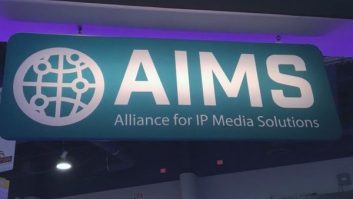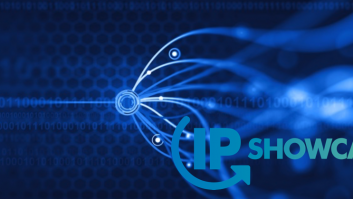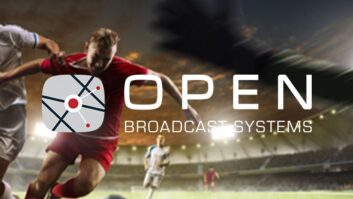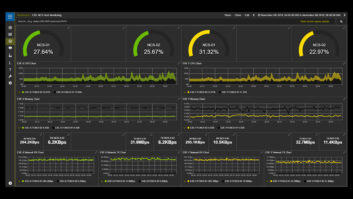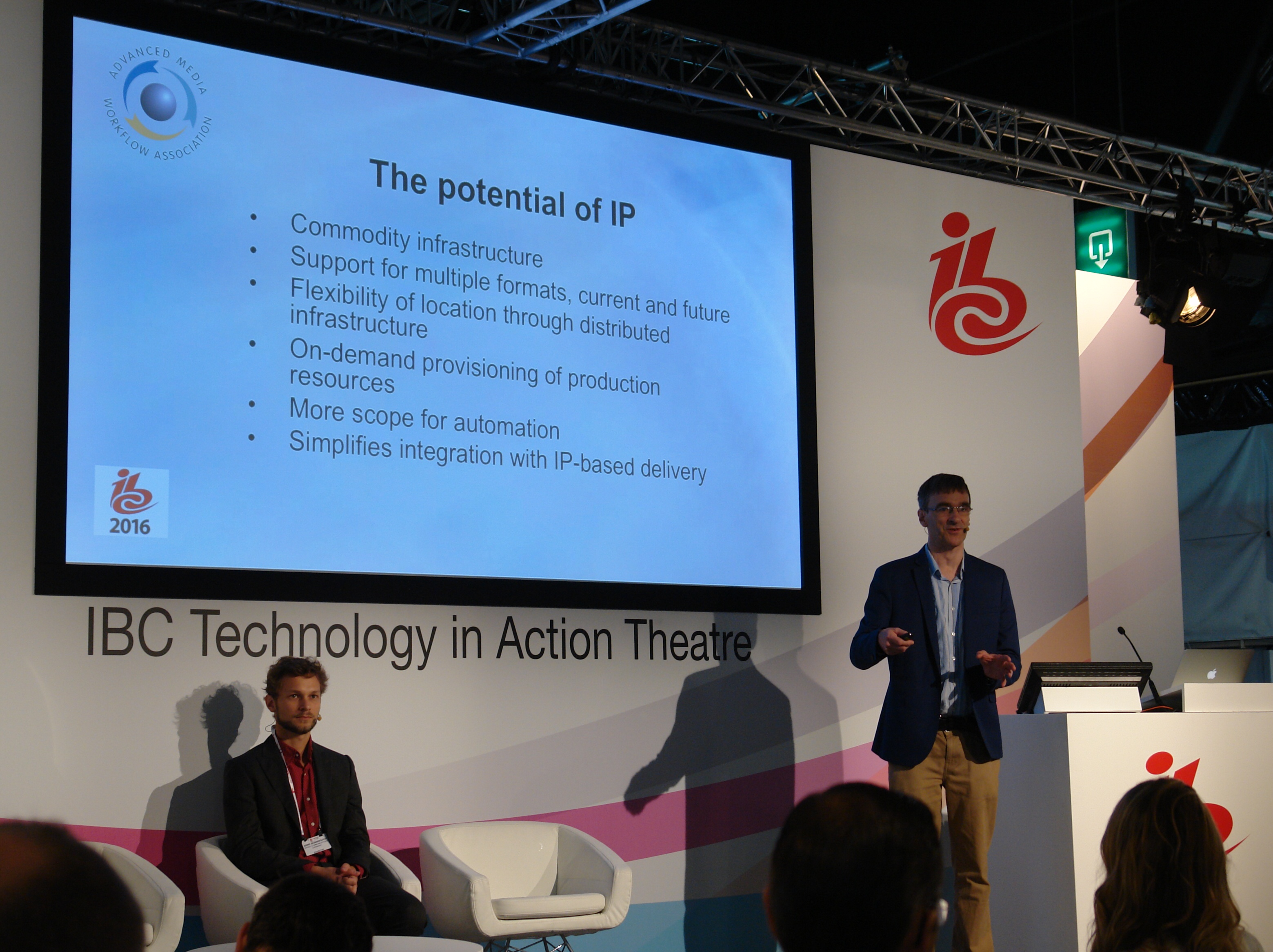
The pallbearers carrying SDI to its grave are finally on their way to the crematorium, but the hearse has encountered delays on route 2110.
Coming out of IBC, the impetus behind IP was immense, thanks to the gathering, under the interoperability banner, of so many industry bodies. We learned that a high capacity, high reliability network is required; the AMWA Incubator was firing on all cylinders thanks in huge part to BBC support; SMPTE 2110 is the promised land; starting small with IP is the key; and, finally, that we are in the first phase of SDI-over-IP, but separating the video and audio streams was pointing to auto discovery and eventually to virtualisation.
The mood dampeners included a continuing evidence of proprietary technologies, and the fact that opting for the central switch approach tended to repeat the SDI experience, rather than trust and join the march to new ways of working.
To ascertain where we stand, inputs come from Brad Gilmer, executive director of AMWA, and Felix Poulin, the EBU’s senior project manager of networked media production.
Laying the foundations for virtualised apps
The discussion with Gilmer started with the Networked Media Incubator Project, which has been a huge enabling factor in support of the ambitions laid out by the EBU/VSF/SMPTE Joint Taskforce on Networked Media (JT-NM), and the progress of SMPTE 2110, which won’t be ratified until 2018.
“The Incubator, guided by the work of the JT-NM, seeks to move quickly to establish initial implementations of critical frameworks for identity, timing, discovery and registration, and connection management. These frameworks were deemed to be absolutely critical if our industry is to unlock the power of IT technology for professional media applications,” he said. “2110 will be a key piece of work. While the SMPTE process needs to proceed with due diligence, clearly manufacturers are moving ahead to ensure that their products meet end-users needs sooner rather than later,” he added. “Many of them are participating in the 2110 discussions to ensure that they can be fully compliant with the standard the moment it is ratified.”
Gilmer backs the VRT example to broadcasters, suggesting they start small with IP and learn the technology before changing complete infrastructures.
“It is a logical business decision to start deploying new technologies in a limited way. The challenge with this technology is that it is a fundamental replacement (over time) of our core infrastructure. So yes, people will start small, but with an eye for how they transition most, if not all of their facility in the future,” he said.
IBC was evidence of a mature first phase. “We saw a very high level of interoperability between different manufacturer products around SMPTE ST-2022-6. There is no question that 2022-6 will find a place alongside the new ST-2110. But many media companies are looking beyond a simple ‘SDI-with-embedded-audio’ solution. This is where 2110 will shine,” said Gilmer.
We saw the separation of the video and audio streams at IBC, which points to auto discovery and eventually to virtualisation.
“As the industry moves to having our video, audio and metadata as first-class citizens in the IT infrastructure, many things become easier to accomplish,” said Gilmer. “The work we are doing now is moving us along that path. Having an extremely accurate, interoperable network timing solution is one example of how we are laying the foundation for many virtualised applications, including live. We have some way to go, but the industry is committed, and concrete progress is being made at a surprisingly rapid pace.”
What of the people who have built a ‘one for one’ replacement for SDI, with central switching that mirrors the way they used to work?
“Many people built file-based workflows that replicated, in great detail, their tape-based workflows, and that is fine. At the end of the day, people have to stay on the air while working through this transition,” said Gilmer.
“Over time, end users learned about the new possibilities that file-based production provided. EBU, SMPTE and the vendors themselves worked to educate the industry about changes that could make end-users more efficient and profitable,” he added. “No doubt the same thing will happen with this transition. Some people will jump to new workflows right out of the gate, but others will simply duplicate what they have on a new infrastructure as part of a ‘crawl, walk, run’ strategy.”
Users seem to want the OPEX model to replace CAPEX, but many are not ready to commit core infrastructures to an outsourcing model.
“Frankly, I don’t know of anyone who wants to fully outsource absolutely all of their CAPEX. Let’s face it – we, as an industry, are still getting to know various cloud providers, and trying to understand how their business models can work with ours,” said Gilmer. “There is some gear-grinding as we go through this process, but there are tremendous business and financial pressures driving this – and a lot of this has to do with laws around taxation.
“We might like to keep all of our infrastructure inside our own four walls, but it is not likely, over the long term, that we can justify this, especially as more and more media companies move to a virtualised, cloud-based infrastructure,” he added.
User groups detect a fair bit of proprietary technology, and many people, including Michel De Wolf, CEO of DWESAM, and Simon Fell, of the EBU, highlighted the issue during IBC. Surely this goes against the user’s desire to buy best of breed?
“This is a natural tension that exists in the marketplace, and the move is not going to make this go away. Vendors look for ways to differentiate themselves. Users look for the freedom to be fickle and ‘date other vendors’ if they want to do so. But in a way, end users cause their own conundrum,” said Gilmer.
“Standards and specifications provide a fundamental foundation of interoperability upon which vendors are encouraged to innovate and do their best work. End-users demand great functionality, and they get it. Then can then take that functionality and move to another vendor with perfect interoperability. This is the nature of what we do,” he added.
What can we expect to see happen in 2017? “The biggest thing I would like to see happen is the development of a clear, open, interoperable model for the description of the capabilities of a device that is discovered on a network,” said Gilmer.
“To move to the next level, we need to plug in a device, and have an open way for that device to describe all of the things it is capable of doing, so that its capabilities can be consumed as part of a dynamic workflow. The FIMS (Framework for Interoperable Media Services) project has a good start on this, and AMWA is hoping to incorporate the nuggets of this into our NMOS (Networked Media Open Specifications) work,” he added. “SMPTE 2110, from the AMWA perspective, is in the rear-view mirror. It still needs to work its way through the standardisation process, but the technology invention is done.
“Soon you will hear about AMWA launching a fast-moving activity to make the first dive into virtualisation and ‘cloudification’. We hope to use this to start fleshing out the work of the JT-NM reference architecture with respect to virtualised facilities,” he continued. “Ultimately, this is likely to lead to new specifications and best practices, which will allow us to truly embrace data centre technology and get even more out of the billions of R&D dollars being spent in the IT community.”
Control of the network
Felix Poulin first considered SMPTE 2110, and the next challenges.
He said: “SMPTE does not predict dates, since the due process is unbounded, time-wise. 2018 means ‘prevision from JT-NM that products will be widely available so that a multi-vendor system can be built using this standard’.
“The good news is that the industry is behind it; even Evertz and Sony acknowledged this is the way as they joined AIMS. We are in a much clearer situation than a year ago, and this reduces uncertainty for users,” he added.
“AMWA IS-04 (NMOS Discovery and Registration) is the other important specification that might see wide implementation in the same timeframe. It is necessary to build bigger systems than VRT LiveIP. The next challenge for standardisation is the control of the network (a lot of different protocols for ‘commodity’ switches) and device capability management: there are many technologies out there like AES-70, FIMS, and Ember+ from Lawo.”
Regarding virtualisation, Poulin observed that few vendors are offering virtualised versions of their hardware products for Live IP production, and believes that it will be a few more years before we can harmonise the approaches and set the best practices.
“There is clearly a demand for training. Progress in interoperability around SMPTE 2110 and AMWA IS-04 is the top priority for JT-NM, and then you will see the resources moving on to the next steps: harmonisation of network control, capability management and later virtualisation,” he said.
Switching to IP is as much about mindset as the technology. Broadcasters want to replace 24/7/365 (and no black screens) with the same thing, and will also want to see a business case if they are going to lose full control and rely on somebody else’s platform/hardware/servers.
“We see two mentalities of network control: the perfect replacement for SDI seems to be SDN, which can guarantee no packet is dropped, but at the cost of losing the self-management features of IP that brings with its flexibility,” said Poulin. “The other way is IP/multicast/QoS with some fault tolerance on the application, and ultimately that will be required for cloud applications. Time will tell if one, the other or both approaches are adopted.”
Workflows are an area mentioned by many users; how should they evolve to engage registration, auto recognition, and various levels of virtualisation? Will revising workflow understanding/evolution be a big part of the education process?
“Most users will start to understand the real benefits the day they see new possibilities. So yes, we need to come to this point, but this is an iterative process. Start with current workflows (like VRT/EBU LiveIP) and then work with the users to figure out new ways that will change the way we integrate the systems,” said Poulin. “Green field systems, where there is no constrains to fit a legacy infrastructure, will be the most revolutionary. We are in exciting times!”
